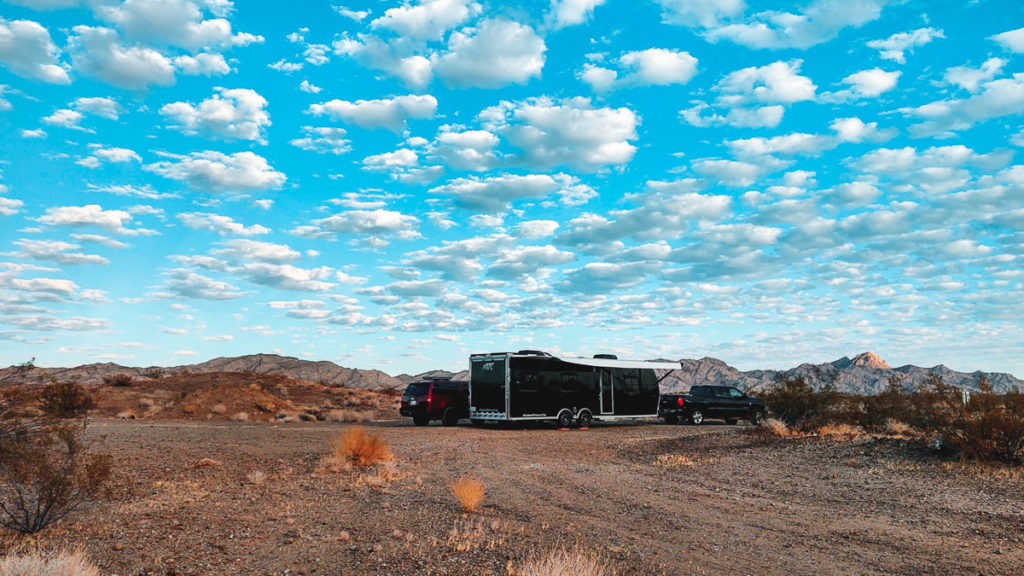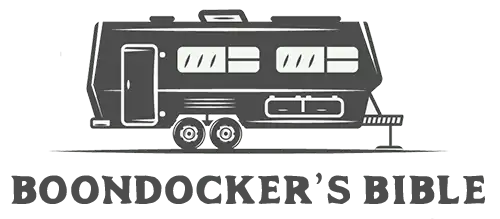BLM camping rules vary depending on the type of BLM land you’re looking at. There are four primary types of BLM lands…
- Open Public Lands
- Developed Recreation Sites and Areas
- Wilderness Areas
- Conservation Lands
Note: See our other article, “What Types of BLM Lands Are There?” for more detail on these types of lands.

Open Public Lands
This is generally what most campers think of when they talk about BLM camping. These are lands that are not otherwise designated for any other use. They are parcels of land, often times vast expanses, that are just open, and free to do almost anything you want. There are rules on what you can and cannot do on these lands. However for the most part, you can pretty much camp as you wish with very little hassle.
Camping Rules for Open Public Lands
These are just the most applicable set of rules for camping on open public lands. Read the full set of rules at “BLM Rules for Visitor Services“.
- You cannot throw trash on the ground. You must either pack it out, or find a trash receptacle.
- You cannot dump your black tank on the ground, nor can you dump petroleum products, chemicals, or other liquid waste on the ground. You cannot dump these things in water, including lakes, streams, reservoirs, etc. Note that dumping “wash water” on the ground is still fine. See also, “Can I Dump my Gray Water on the Ground?“
- There’s generally a 14-day camping limit. However, each BLM field office is free to establish their own camping limits. Most use the 14-day limit, but some go longer. You may want to check with the local BLM field office just in case they allow more than 14-days.
- You cannot leave your camp unattended for more than 10 days (12 months in Alaska). Once you set up camp, you’re expected to be there with your stuff. Otherwise, the BLM is authorized to confiscate it.
- You cannot make unreasonably loud noises, create hazards or nuisances.
- You cannot intentionally destroy, deface, or remove anyone else’s personal property, nor any natural, scientific, cultural, historical, or archaeological objects. The exception to this, you can pick flowers, berries, seeds, vegetation, for personal use, and you can also collect firewood as long as your collecting off the ground or cutting off dead branches.
- You cannot drive off-road. Your vehicle must remain on established roads and previously-used clearings. Read, “Can I Drive my RV Off-Road on BLM Land?“
Developed Recreation Sites and Areas
These are areas where the BLM has completed some degree of development for recreational purposes. Sometimes that development could be as simple as setting up picnic tables, fire rings, trash dumpster, and a information kiosk. But it can also go on to include parking lots, interpretive centers, pit toilets, ADA compliant campsites, wildlife viewing decks, dump stations, etc.
Camping Rules
The BLM has created a set of general rules that apply to all such areas across the country, but each area also carries its own unique set of rules. You will have to visit the area to find a sign or information kiosk with these rules, or contact the local BLM field office.
General Rules
Below is the set of general rules that apply to all developed areas nationwide. These have been condensed for easier reading. To view the complete set of rules and exact wording see, “BLM Rules for Visitor Services“.
- You are not allowed to clean fish, game, other food, clothing or household articles at any outdoor hydrant, pump, faucet or fountain, or restroom water faucet.
- You are not allowed to deposit human waste except in toilet or sewage facilities provided for that purpose.
- You are not allowed to bring an animal into an area unless it’s on a leash not longer than 6 feet.
- You are not allowed to make loud noises, including radios, musical instruments, or other devices, that disturbs visitors.
- You are not allowed to operate or use a public address system.
- You are not allowed to construct, erect or use an antenna fixed into the ground or to other site facilities.
- You are not allowed to camp in areas not designated for camping.
- You are not allowed to leave personal property unattended for more than 24 hours in a day use area, or 72 hours in other areas.
- You are not allowed to build any fire except in a stove, grill, fireplace or ring provided for such purpose.
- You are not allowed to move any table, stove, barrier, litter receptacle or other campground equipment.
- You are not allowed to drive your vehicle on lands not intended for vehicular use.
- You are not allowed to use firearms, weapons, or fireworks. You can still bring weapons, you just can’t use them, unless for hunting.
- You are not allowed to bring an animal, except a Seeing Eye or Hearing Ear dog, to a swimming area.
Wilderness Areas
These are very specific areas of land designated under the Wilderness Act of 1964. Basic recreational activities (camping, hiking, wildlife viewing) are permitted on wilderness areas.
The only difference between wilderness areas and other areas is that you cannot drive a vehicle or operate any kind of mechanical or electric devices. This includes bicycles, drones, even pulling a handcart. The only type of camping allowed here is tent camping, or sleeping on the ground. A good rule of thumb to remember is to pretend like its the 1800s, and imagine camping that way.
The good news is that most wilderness areas have some kind of service road that lies outside their boundaries. You can drive your RV or vehicle on these roads, and even camp along side the road, as long as you keep the vehicle outside the wilderness boundaries.
Otherwise, the rules for camping in wilderness areas remains similar to that of Open Public Areas (see above).
Camping Rules
Below are general rules that apply to all wilderness areas. Refer to the full set of rules, “BLM Rules for Wilderness Areas“. Make sure to check with the local BLM field office to get specific rules unique to a wilderness area.
- You cannot drive a vehicle on wilderness areas. Everything must be hiked in.
- Campfires are generally not allowed. You can, however, use camp stoves, lanterns, even portable heaters.
- You cannot gather plants, flowers, rocks, animals, animal remains, nothing. You cannot gather firewood or cut trees.
- You cannot erect any kind of structure with the exception of tent camps, fold up tables and chairs, et al.
- You cannot organize any kind of event on a wilderness area (camping meetup, et al.)
- How long you can remained camped on a wilderness area varies with each area. Contact the local BLM field office.
Conservation Lands
These are areas of land that were designated by Congress or by an executive order by the President. These include national monuments designated under the Antiquities Act of 1909, the National Trails Act of 1968, and the Wild and Scenic Rivers Act of 1968.
Examples of these lands include Grand Staircase Escalante National Monument in Utah, the Mojave Trails National Monument in California, the Continental Divide National Scenic Trail in New Mexico, and the John Day Wild and Scenic River in Oregon.
Camping Rules
Each conservation land has its own unique set of camping rules. There is no single set of general rules that apply nationwide.
Most of these lands have both developed campgrounds as well as areas for dispersed camping. Most of these lands have their own websites and will often publish these rules. These areas usually have a visitor center where you can inquire about camping rules.


Can’t find specifically how far to dispersed camp from a stock pen or tank. I seem to remember something like 400′, but would like to confirm/not piss off any cowboys.
The BLM does not have any national rules regarding camping setbacks. However, there are some BLM field offices that have enacted setbacks from developed areas or water bodies, so it depends on the location. The State of Arizona has a 1/4 mile camping setback from a waterbody or watering tank, but this only applies in cases where animals are blocked from getting a drink.